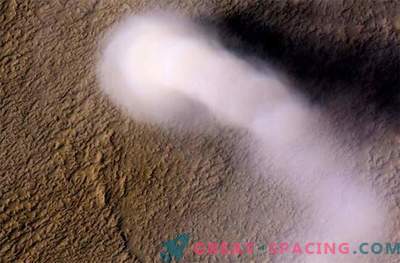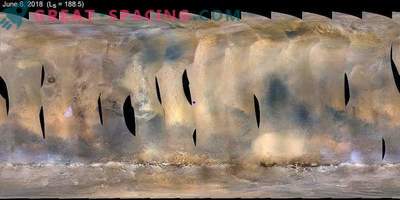
Self-portrait, made by NASA Curiosity rover on June 15, 2018 (2082 sol). Martian Dust Storm Swallows Sunlight in Gail Crater
A storm of small dust particles swallowed up most of the Red Planet over the past two weeks, due to which the NASA Opportunity Rover had to suspend its operations. The device is powered by sunlight, closed by dust, so it has to stay at the current location. But the Curiosity rover has a nuclear battery that allows you to work day and night.
Recent data indicate that the storm has increased in size. Although Curiosity is on the other side of Mars from Opportunity, the dust follows the vehicle and halved the distance over the weekend. Solar haze (tau) is now above 8.0 in Gale Crater (this is the highest tau recorded by the mission). Near Opportunity, tau is above 11 and it is tight enough so that the oldest Martian rover cannot perform accurate measurements.
Now scientists use Curiosity to answer the most important question: why do some Martian dust storms last for months and grow, while others remain small and limited to weekly activity? Curiosity will allow for the first time to collect information about dust from both the surface and from space. The last global storm on Mars fell in 2007, 5 years before the landing of Curiosity.

Two images from Mastcam on the NASA Curiosity rover show atmospheric changes as the dust storm descended to Gale Crater. On the left - the drilling site “Duluth” (May 21), on the right - the point on June 17
The top image shows how Curiosity is located on the edge of a crater 30 km from where it previously was. Daily images show the process of darkening the sky. The created haze is about 6-8 times denser than usual at this time of year.
Curiosity engineers from Pasadena's Jet Propulsion Laboratory explored the potential of an increasing dust storm to affect rover tools. No greater risk is foreseen. The greatest influence falls on the camera apparatus, needing additional exposure time due to low light.
Martian dust storms are commonplace, especially in the southern hemisphere in spring and summer, when the planet is closest to the Sun. As the atmosphere warms up, winds caused by high temperature contrasts mobilize dust particles. Carbon dioxide, frozen on a winter polar cap, evaporates, thickening the atmosphere and increasing surface pressure. Sometimes dust clouds rise to a height of over 60 km.
Despite the prevalence of the phenomenon, dust clouds usually occupy a local position. But the current storm is growing in scale and covers the territories of Russia and North America combined.











































